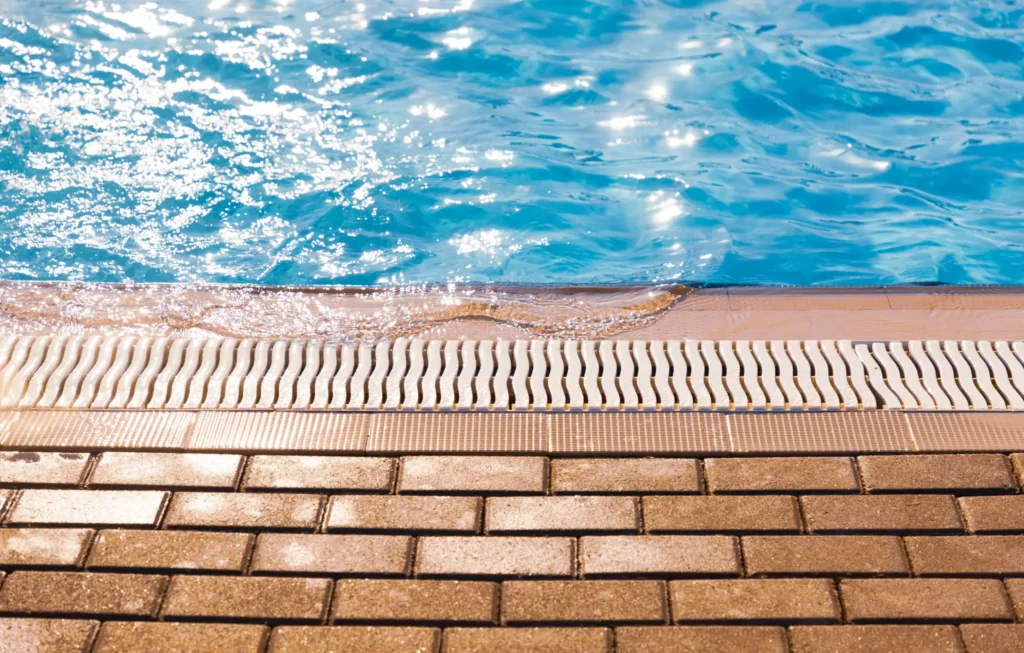What Is Pool Coping?
When it comes to designing a swimming pool, every detail counts—but few features are as crucial as the poolside coping. Serving a vital role in pool structure and aesthetics, pool coping is much more than just an accent; it’s an essential component for every pool owner to consider. In this comprehensive guide, we’ll delve into the various aspects of swimming pool coping, ensuring you make an informed decision for your backyard paradise.
Why is Pool Coping Important?
Pool coping acts as a protective cap for the edge of the pool, and prevents water from seeping behind the pool shell, mitigating damage to the pool structure and surrounding deck. It forms a barrier against water damage and corrosion, ensuring the longevity of your pool.
Coping provides a non-slip surface for swimmers, enhancing safety by reducing the risk of falls while entering or exiting the pool. This functional feature also creates a seamless edge that guides splashed water back into the pool, helping to maintain the chemical balance of the water and ensuring proper drainage.
Debris can be a pool’s enemy, and coping stands as the first line of defense in keeping the pool clean. The right coping can weather seasonal shifts and prevent expansion and contraction that may lead to cracks and damage.
In terms of aesthetics, pool coping opens up a myriad of design choices, allowing pool owners to customize the appearance of their pools to compliment their outdoor living space. With an array of materials like concrete, stone, tile, and brick to choose from, selecting the right pool coping can elevate the look of your pool area while simultaneously providing essential protection and functionality.
Whether you are refurbishing an existing pool or installing a new one, never underestimate the importance of choosing the right coping for pools. Legacy is more than just another pool company in Richmond, we take the time to find the right materials and plan construction to make sure your poolside is safe and protected.
What are the Different Types of Pool Coping?
Concrete Pool Coping
This can be one of the most versatile and cost-effective options. Concrete coping offers flexibility in terms of design and finishes. It can be shaped and molded to match the exact contour of your pool, and you can choose from poured-in-place concrete, precast concrete, or even concrete pavers.
Natural Stone Pool Coping
Natural stones are particularly sought after for their unique aesthetics and long-lasting qualities. Some commonly used stones are travertine, flagstone, limestone, slate, granite and sandstone.
Paver Pool Coping
This type of coping is made from various materials, including brick, concrete, or natural stone, fashioned into individual pavers that can be laid down to create a cohesive and aesthetically pleasing border around the pool.
Brick Pool Coping
This option consists of bricks that have been specifically treated for water resistance and can withstand the chemicals commonly found in pool water.
Bluestone Pool Coping
This natural stone can withstand the rigors of the elements, such as chlorine and salt. It comes in a variety of shades from blue to gray that enhance the overall look of the pool.

What is the Average Cost of Pool Coping?
Pool coping costs can vary depending on materials, complexity of design, and whether you’re incorporating it into a new pool build or retrofitting an existing pool. The average cost for pool coping will range from $8,000-$10,000 for most residential pools. But, the various materials that can be utilized for pool coping each have their own price point and installation requirements.
If you already have a coping edge around your pool, you can consider pool coping replacement costs instead of installing a whole new design. The experts at Legacy Pools can work with you to find the best material and construction plan that meets your design wishes and sticks to your budget.
How is Pool Coping Installed? A Step by Step Process
- Preparation of the Pool Edge: This typically means ensuring the substrate or bond beam—the horizontal structure that sits at the top of the pool shell—is level and clean. Any debris, existing coping, or loose materials will be thoroughly removed to create a solid foundation for the new coping.
- Cutting to Fit: Depending on the coping material chosen, it may need to be measured and cut to fit snugly around the pool’s perimeter. This step requires precision and careful consideration of any curves or corners in the pool design.
- Mortar Application: Mortar, or a similar bonding material, is then applied to the prepared edge and the underside of the coping to secure it into place. The consistency and application of the mortar are critical; it needs to be thick enough to hold the coping but smooth enough to allow for adjustments and leveling.
- Setting the Coping: After applying the mortar, each coping piece is carefully placed on top of the bond beam. Installers will check to ensure that each section is level and aligned correctly with adjacent pieces. It is important that installers work relatively quickly before the mortar hardens, making adjustments difficult.
- Joint Filling: Once the coping is set into place and the mortar has dried, the next step is to fill in the joints between each coping piece. This is often done with grout, which prevents water from seeping between the coping and the pool structure. The choice of grout color can also be used to complement or contrast the coping.
- Curing and Cleaning Up: After the coping is installed, it’s important to allow sufficient time for it to cure properly. If you are experiencing issues with your poolside coping but aren’t ready for a whole new installation, Legacy Pools offers pool deck crack repair.
Adding coping to your pool involves strategic planning and careful craftsmanship. When you enlist the help of the experts at Legacy Pools, you can rest easy knowing you will be getting this thorough step by step process.

Get the Right Types of Pool Coping
Pool coping is not only an essential component in the design and functionality of a swimming pool, but it also plays a critical role in the overall aesthetic and durability of the pool environment. By understanding the different materials available, considering the various styles that complement your design, and implementing strategic pool coping installation methods, homeowners can elevate the safety, value, and appeal of their pools.
Whether you’re in the market for a renovation or are just beginning the pool-building journey, the experts at Legacy Pools, who offer pool services in Richmond, VA, can help you find the right coping that will make all the difference in the outcome of your project. We are the locally-owned and operated pool company that the Richmond community can count on. Legacy is dedicated to being your partner in pool ownership so that your vision is our Legacy!
